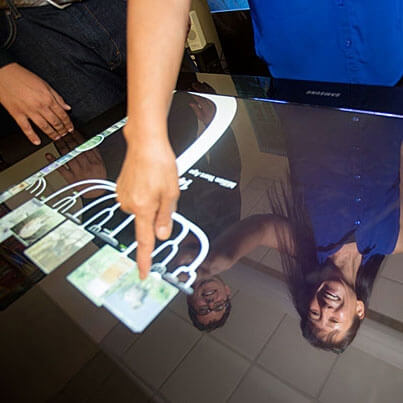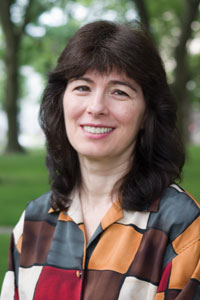News
Innovation is an increasingly important part of Harvard. The interactive FloTree at the Harvard Museum of Natural History, designed by Chia Shen's research group at SEAS, is a tangible example. (Photo by Kris Snibbe, Harvard Staff Photographer.)
This is the third of four reports in the Harvard Gazette that echo key themes of The Harvard Campaign and examine what the University is accomplishing in those areas.
Innovation? For centuries, that was not Harvard’s long suit. When it opened in the 17th century, New England’s first college was a regional institution for educating ministers and lawyers. Tutors and professors — fewer than a dozen each until after the Civil War — hewed to a curriculum of classics and rhetoric that originated in the Middle Ages. Until a few generations ago, facility in Latin was required for entering freshmen.
Today, and in accelerating ways for decades past, “Harvard” and “innovation” may as well be spelled the same. Pressing for the new to solve the old has entered the fabric of the curriculum, from humanities and the arts (where digital frontiers are being breached) to the sciences, whether pure, applied, or social.
“Harvard is about possibilities,” said President Drew Faust in her remarks Sept. 10 opening the academic year. “Here, it’s possible to change how our successors will think about learning and teaching.” She delivered similar comments in launching The Harvard Campaign last Saturday.
The Harvard innovation picture can reflect a solo effort, as in the case of Olenka Polak ’15, whose app, myLINGO, can translate foreign movies in real time. Or innovation can be a team effort — the mainstay of bench science — like the work of a group run by chemical biologist Xiaoliang Sunney Xie that is investigating life forces at the level of single molecules in live cells.
Some innovations are the province of Harvard institutions. They can have likely names, such as the i-lab, which stands for Harvard Innovation Lab, a 10-School, border-breaking engine of interdisciplinary creativity. Another is the Government Innovators Network at the Harvard Kennedy School’s (HKS) Ash Center. There are innovation-driven entrepreneurship centers at Harvard Business School (HBS) and the School of Engineering and Applied Sciences (SEAS).
In such places, Faust said, Harvard’s entrepreneurs “are building apps and businesses and cultural enterprises.”
Engineers out at the edge
SEAS is pronounced “seize,” as in, seize every opportunity to make the new and remake the old. Research projects under way there include developing a soft and wearable “exosuit” that supports the human body while carrying heavy loads (from Conor Walsh) and adaptive camouflage inspired by cuttlefish (from Joanna Aizenberg). Over the summer, a new student group called Nanostart began creating a community around nanoscale innovation and entrepreneurship. Graduate students, researchers, and companies come together to brainstorm inventions.
Courses at SEAS point right at innovation. This semester, the traditional ES 96 (a required junior-level design course for concentrators in the engineering sciences) will take on therapeutic uses for manufactured human cells. The goal of ES 96, as always, is to teach design theory through a hands-on project....
Read the entire article in the Harvard Gazette
Cutting-edge science delivered direct to your inbox.
Join the Harvard SEAS mailing list.
Scientist Profiles
Joanna Aizenberg
Amy Smith Berylson Professor of Materials Science and Professor of Chemistry & Chemical Biology

